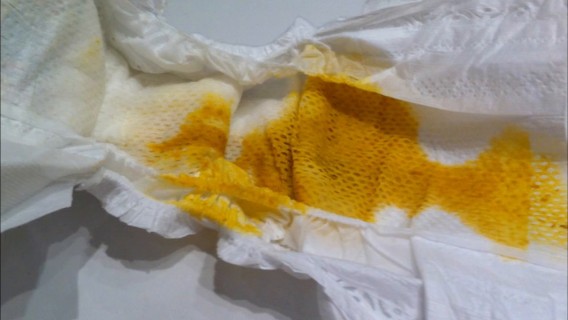It can be reassuring for you to be able to recognise the following:
Meconium.When you have a new baby, you soon become obsessed with their poo! You’ll keep an eagle eye (and sniffer-dog nose) on how many they do a day, the colour and consistency of what they produce and how it smells. For your peace of mind, in our video, we show you what’s normal and what’s not.
Here is a summary of what to look out for –
If your baby has pale or white stools take her (along with her dirty nappy) to see your doctor immediately. There is a rare condition called biliary atresia which causes babies to have white or pale poo due to obstruction in the flow of bile. This can be serious so must be reported immediately.
Meconium is the black tar-like poo that your baby produces soon after birth. If you give birth in a hospital, the doctor will generally want to know that your baby has successfully produced meconium before they can be discharged. This usually happens 12-24 hours of the birth and is a good sign that your baby’s digestive system has started to move and peristalsis (the small contractions that move food along the gut) is working. Over the next few days, your baby’s poo will change from black to greeny-brown and become less sticky. You may notice it to also appear a little seedy and this is normal as baby if clearing his gut from material that has been lying there through pregnancy. By around day 4-5 your baby’s poo will change to a yellow colour (and less sticky consistency) as the meconium passes through baby’s system.
The reason your baby’s meconium looks so strange is that while your baby is growing in the uterus all her food is transported via the placenta and umbilical cord directly into her bloodstream – like an intravenous drip. Babies in the uterus don’t need to digest and absorb food but they do swallow amniotic fluid. Meconium is basically amniotic fluid baby poo. The more meconium your baby passes the better as if it stays in your baby’s gut for long baby will begin to reabsorb bile which is a constituent of meconium and that will result in him developing jaundice. The good news is that your colostrum contains a strong laxative so the more your baby feeds the quicker he will poo out all the meconium.
If your baby doesn’t produce meconium within 24-48 hours of the birth, it’s vital to tell your baby’s doctor or midwife. On rare occasions, delayed production of meconium can mean there is a blockage in a baby’s gut which may require surgery to unblock.
When your baby is born, they should l begin feeding within an hour of birth and as they start to digest your breastmilk or formula milk you will see their poo evolve from dark tar-like meconium to digested milk poo.
Green poo can be completely normal for new babies. As the poos changes from meconium, it can look dark greeny-brown for a day or two. It’s more common in babies with colds as the mucus speeds up movement through the gut. If your baby is growing well and the baby poo is a normal, soft texture there is probably nothing to worry about and part of the natural transition from meconium to digested milk poo.
However, if your baby has other symptoms such as reflux or eczema and the green poo is persistent, speak to your doctor. If your baby is having a bad reaction to dairy proteins you might expect to see green poo, with mucous and an unusual texture.
A lot of new mums worry that if their baby has green poo it means their milk isn’t fatty enough or that their baby is getting too much ‘foremilk’ – however, this would be reflected in low weight gain. If you are worried monitor your baby’s weight gain with regular measurements at your local well-baby clinic.
If your newborn baby is producing green poo and seems very unsettled, it is important to make sure that your baby is latched on at the breast and feeding well. Visit your local breastfeeding drop-in group or talk to your health visitor or GP if you are worried.
It is also worth getting persistent green poo checked out, particularly if you are worried about any other symptoms.

Breastmilk is the perfect food for babies and it’s digested and absorbed very well. Poo is particularly useful for breastfeeding parents as it’s a great well to be able to see that your baby is getting exactly what he needs. Once the colostrum has started to transition to mature milk (at around day 2-5), we expect to see at least 2 poos every 24 hours. They may be the size of a £2 coin (U.S quarter) or they can be much bigger. After around 4-6 weeks, some breastfed babies start to poo less frequently but when a very young baby isn’t pooing, we need to mention it to our midwife, doctor or health visitor.
It is mainly yellow (like korma sauce) due to bile being released into the gut from the gallbladder. The bile contains a protein called bilirubin which is made from the breakdown of old red blood cells.
It is sometimes full of little seed-like grains and has a sweet, not unpleasant smell.
Formula-fed babies tend to produce more baby poo than breastfed babies as they can’t digest as much of the formula milk. Formula fed poo is also browner – more like peanut butter! It’s smellier than breastfed poo but not as smelly as a baby who eats solids.

Formula fed babies are more prone to constipation than breastfed babies so it’s really important that you make up the formula exactly as it’s advised on your baby’s formula packaging. Never add an extra scoop to help them sleep or ‘help them to grow’ as you will increase the risk of painful constipation and your baby may receive too many calories which can have long-term implications on their weight and health.
If your baby is constipated you will notice them straining for some time before passing a hard stool that may be streaked with blood. Streaks of blood in poo can be due to a little tear in the anus. Always get your baby checked out by a doctor if there’s blood in their nappy just to be on the safe side.
Diarrhoea is characterised by strong-smelling watery poo and is generally caused by a tummy bug. You must keep your baby well hydrated if she has diarrhoea. She can also quickly get a nasty nappy rash. If you are breastfeeding continue to feed as often as your baby needs as this will not only help hydrate her but also provide antibacterial properties to help her recover faster.
Blood in diarrhoea can be a sign that your baby is fighting a bacterial infection and may need antibiotics so take your baby and her nappy (as a specimen) to your doctor immediately.
If there is blood in your baby’s poo it’s important to take the nappy along to the doctor to assess where the blood has come from and what has caused it. It can be caused by severe nappy rash or an anal fissure (a small cut near your baby’s bottom often caused by straining with constipation). If your older baby is drinking cow’s milk and their poo is basically normal but you can see tinges of blood, he may have an allergy to cow’s milk protein. Around 5% of babies have an allergy to the proteins in cow’s milk so speak to your doctor about changing to a safe milk for your baby to drink.
If there seems to be white or clear mucus along with the poo then mention this to the doctor, especially if your baby is very young as it may indicate a medical problem.
If you are breastfeeding and experiencing some nipple soreness, it might be that your baby is ingesting a little of your blood from a damaged nipple which you might then see signs of in baby’s nappy. This kind of blood will not appear fresh in nappies but more of a blackish colour. It’s not harmful for your baby to swallow small amounts of your blood but it’s a good idea to still talk to your health care professional – not least because it sounds like you need some help positioning and attaching baby while you breastfeed.

Your baby’s poo can a helpful barometer of her health, hydration and diet so it’s a good idea to always note what your baby’s poo is like and if it changes after certain foods. You can then use your baby’s poo as an early warning system to alert you in case she: